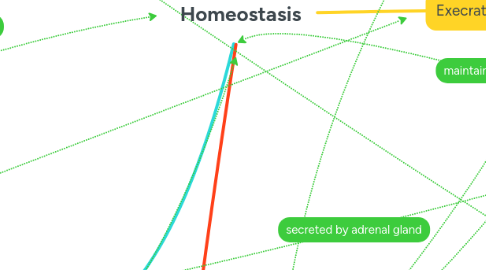
1. Execratory System
1.1. Kidneys
1.1.1. Antidiuretic Hormone (ADH)
1.1.1.1. encourages aquaporins to reabsorb water in the nephron
1.1.2. blood vessels - transport blood to kidneys to be filtered
1.1.3. nephrons - filter the blood
1.1.3.1. Bowman's capsule: separates molecules (glucose, ions, amino acids, and water) and blood cells
1.1.3.2. Descending loop of Henle
1.1.3.2.1. aquaporins - transport waters between cells
1.1.3.3. Ascending loop of Henle
1.1.3.3.1. reabsorption of water & ions
1.1.4. aldosterone - controls the secretion of H+ and K+ ions back into the distal tubule.
1.1.5. Secretion - removal of waste products in blood & interstitial fluid
1.1.5.1. bladder - stores the waste (urine)
1.1.5.2. H+ and bicarbonate ions
1.2. Bladder
2. Endocrine System
3. Reproductive system
3.1. Female
3.1.1. Gonadotropin releasing Hormones (GnRH) controls hormones from the anterior pituitary
3.1.2. Follicle stimulating hormone (FSH) & Luteinizing hormone (LH)
3.1.2.1. FSH stimulates oocyte development & follicle growth. LH is responsible for maturing the egg and releasing it.
3.1.2.2. corpus luteum grows once egg is released.
3.1.2.2.1. releases estrogen, progesterone and inhibin hormones
3.1.3. If pregnancy occurs, embryo will relase the hormone Human Chorionic Gonadottropin (hCG)
3.1.4. Ovaries (gonads), produces steroid hormones
3.1.4.1. Steroid hormones: androgens, estrogens, and progestins (aides in the process reproductive systems, sexual characteristics, and mating behaviors'.)
3.2. Male
3.2.1. Testes (gonads)
3.2.1.1. Sperm matures, androgens (testosterone) secreted
3.2.1.1.1. spermatogenesis - production of sperms
3.2.1.1.2. Testosterone - stimulates sperm production, growth and fucntion of the male reproductive structures
3.2.1.2. scrotum
3.2.1.3. vas deferens - transports sperm from the epididymis to urethra (removal of sperm)
3.2.1.4. Urethra
4. Blood sugar regulation
4.1. Diabetes Mellitus
4.1.1. Type 1 Diabetes
4.1.2. Type 2 Diabetes
4.2. Pancreas
4.3. glucocorticoids (connected to stress response)
4.4. Islet of Langerhans
4.4.1. group of endocrine cells - releases hormones into bloodstream
4.4.1.1. Alpha cells
4.4.1.1.1. Glucagon
4.4.1.2. Beta cells
4.4.1.2.1. insulin
5. Nervous system
5.1. The Brain
5.2. Central Nervous system (CNS) - contains the brian & spinal cord
5.3. Peripheral Nervous System (PNS) - contains all other nerves
5.3.1. Afferent system
5.3.1.1. Senses & stress
5.3.2. Efferent system
5.3.2.1. Stomatic - voluntary control
5.3.2.2. Autonomic - involuntary control
5.3.2.2.1. Sympathetic
5.3.2.2.2. Parasympathetic
6. Endocrine system
6.1. Endocrine glands - ductless and release hormones directly into the blood or interstitial fluid
6.1.1. Insulin & glucagon are endocrine hormones (travel through the blood)
6.2. Hormones -
6.2.1. Peptide hormones
6.2.2. Steroid hormones
